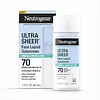What's inside
What's inside
 Key Ingredients
Key Ingredients

 Benefits
Benefits

 Concerns
Concerns

 Ingredients Side-by-side
Ingredients Side-by-side

Homosalate 8%
Skin ConditioningEthylhexyl Salicylate 4%
UV AbsorberButyl Methoxydibenzoylmethane 3%
UV AbsorberOctocrylene 2%
UV AbsorberWater
Skin ConditioningCyclomethicone
EmollientIsostearyl Neopentanoate
EmollientGlycerin
HumectantCeteareth-20
CleansingCetearyl Alcohol
EmollientSodium Hyaluronate Crosspolymer
HumectantSpinacia Oleracea Leaf Extract
Skin ConditioningCamellia Sinensis Leaf Extract
AntimicrobialAlteromonas Ferment Extract
Skin ConditioningCaprylyl Glycol
EmollientXanthan Gum
EmulsifyingPEG-40 Stearate
EmulsifyingTriacontanyl Pvp
HumectantSilica
AbrasiveAmmonium Acryloyldimethyltaurate/Vp Copolymer
Butylene Glycol
HumectantTriethanolamine
BufferingCetyl Dimethicone
EmollientCaprylhydroxamic Acid
Disodium EDTA
Parfum
MaskingTocopheryl Acetate
AntioxidantHelianthus Annuus Seed Oil
EmollientHomosalate 8%, Ethylhexyl Salicylate 4%, Butyl Methoxydibenzoylmethane 3%, Octocrylene 2%, Water, Cyclomethicone, Isostearyl Neopentanoate, Glycerin, Ceteareth-20, Cetearyl Alcohol, Sodium Hyaluronate Crosspolymer, Spinacia Oleracea Leaf Extract, Camellia Sinensis Leaf Extract, Alteromonas Ferment Extract, Caprylyl Glycol, Xanthan Gum, PEG-40 Stearate, Triacontanyl Pvp, Silica, Ammonium Acryloyldimethyltaurate/Vp Copolymer, Butylene Glycol, Triethanolamine, Cetyl Dimethicone, Caprylhydroxamic Acid, Disodium EDTA, Parfum, Tocopheryl Acetate, Helianthus Annuus Seed Oil
Titanium Dioxide 6.6%
Cosmetic ColorantZinc Oxide 14.4%
Cosmetic ColorantWater
Skin ConditioningCaprylic/Capric Triglyceride
MaskingGlycerin
HumectantButyloctyl Salicylate
Skin ConditioningEthylhexyl Methoxycrylene
Skin ConditioningVp/Hexadecene Copolymer
Dimethicone
EmollientSteareth-21
CleansingCalcium Sodium Borosilicate
Triacontanyl Pvp
HumectantPolyhydroxystearic Acid
EmulsifyingAluminum Hydroxide
EmollientStearic Acid
CleansingTriethoxycaprylylsilane
Cetearyl Olivate
Phenoxyethanol
PreservativeSodium Chloride
MaskingXanthan Gum
EmulsifyingEthylhexylglycerin
Skin ConditioningSorbitan Olivate
EmulsifyingChlorphenesin
AntimicrobialCaprylyl Glycol
EmollientTocopheryl Acetate
AntioxidantDisodium EDTA
Titanium Dioxide 6.6%, Zinc Oxide 14.4%, Water, Caprylic/Capric Triglyceride, Glycerin, Butyloctyl Salicylate, Ethylhexyl Methoxycrylene, Vp/Hexadecene Copolymer, Dimethicone, Steareth-21, Calcium Sodium Borosilicate, Triacontanyl Pvp, Polyhydroxystearic Acid, Aluminum Hydroxide, Stearic Acid, Triethoxycaprylylsilane, Cetearyl Olivate, Phenoxyethanol, Sodium Chloride, Xanthan Gum, Ethylhexylglycerin, Sorbitan Olivate, Chlorphenesin, Caprylyl Glycol, Tocopheryl Acetate, Disodium EDTA
 Reviews
Reviews

Ingredients Explained
These ingredients are found in both products.
Ingredients higher up in an ingredient list are typically present in a larger amount.
Caprylyl Glycol is a humectant and emollient, meaning it attracts and preserves moisture.
It is a common ingredient in many products, especially those designed to hydrate skin. The primary benefits are retaining moisture, skin softening, and promoting a healthy skin barrier.
Though Caprylyl Glycol is an alcohol derived from fatty acids, it is not the kind that can dry out skin.
This ingredient is also used as a preservative to extend the life of products. It has slight antimicrobial properties.
Learn more about Caprylyl GlycolDisodium EDTA plays a role in making products more stable by aiding other preservatives.
It is a chelating agent, meaning it neutralizes metal ions that may be found in a product.
Disodium EDTA is a salt of edetic acid and is found to be safe in cosmetic ingredients.
Learn more about Disodium EDTAGlycerin is already naturally found in your skin. It helps moisturize and protect your skin.
A study from 2016 found glycerin to be more effective as a humectant than AHAs and hyaluronic acid.
As a humectant, it helps the skin stay hydrated by pulling moisture to your skin. The low molecular weight of glycerin allows it to pull moisture into the deeper layers of your skin.
Hydrated skin improves your skin barrier; Your skin barrier helps protect against irritants and bacteria.
Glycerin has also been found to have antimicrobial and antiviral properties. Due to these properties, glycerin is often used in wound and burn treatments.
In cosmetics, glycerin is usually derived from plants such as soybean or palm. However, it can also be sourced from animals, such as tallow or animal fat.
This ingredient is organic, colorless, odorless, and non-toxic.
Glycerin is the name for this ingredient in American English. British English uses Glycerol/Glycerine.
Learn more about GlycerinTocopheryl Acetate is AKA Vitamin E. It is an antioxidant and protects your skin from free radicals. Free radicals damage the skin by breaking down collagen.
One study found using Tocopheryl Acetate with Vitamin C decreased the number of sunburned cells.
Tocopheryl Acetate is commonly found in both skincare and dietary supplements.
Learn more about Tocopheryl AcetateWe don't have a description for Triacontanyl Pvp yet.
Water. It's the most common cosmetic ingredient of all. You'll usually see it at the top of ingredient lists, meaning that it makes up the largest part of the product.
So why is it so popular? Water most often acts as a solvent - this means that it helps dissolve other ingredients into the formulation.
You'll also recognize water as that liquid we all need to stay alive. If you see this, drink a glass of water. Stay hydrated!
Learn more about WaterXanthan gum is used as a stabilizer and thickener within cosmetic products. It helps give products a sticky, thick feeling - preventing them from being too runny.
On the technical side of things, xanthan gum is a polysaccharide - a combination consisting of multiple sugar molecules bonded together.
Xanthan gum is a pretty common and great ingredient. It is a natural, non-toxic, non-irritating ingredient that is also commonly used in food products.
Learn more about Xanthan Gum